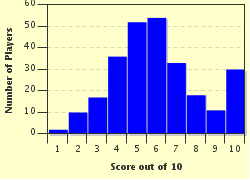Quiz Answer Key and Fun Facts
1. The WHAM-O company manufactured this toy made from Zectron, an extremely elastic material. It was made of a synthetic rubber that was invented in 1964 by Norman Stingley. What was the name of this absolutely amazing toy, that could literally fly over a three-story building?
2. Hey, do you remember an early 1960's fad called "troll dolls"?
You remember - they had that really long fuzzy hair, and their little smiling plastic faces were just all wrinkled up around those fat little cheeks and they had those great big bright eyes.
What nationality was the poor man who fashioned the first one from wood, so that his daughter could have a Christmas toy to play with?
3. Did you have one of these to play with? Nothing could be more fun than a "Barrel of Monkeys".
What company ORIGINALLY produced this game, way back in 1965?
4. Ohio Art introduced us to this toy in 1960 that used aluminum powder as one of its main "ingredients".
What was this toy that the company offered to us, just in time for us to receive them as Christmas gifts that year?
5. Eva Gabor and Johnny Carson once played this popular kid's game on "The Tonight Show" in 1966, creating an instant sensation.
What was the name of this controversial but fun children's game that was produced by The Milton Bradley Company?
6. A toy that traces it roots back to the late 1930's became quite popular by 1964. That's when WHAM-O decided to call this flying disc by the name most of us now know it by, the Frisbee.
By what THREE names had it previously been called?
7. Here we have a very *HOT* toy item; that probably could not even be marketed in today's world. That's because it really WAS hot! Literally.
What was the name of the company that manufactured a series of toys with built-in heaters that we used to melt down a substance called "Plastigoop" in order to produce all sorts of plastic things like bugs, cars, flowers, people, dragons, etc.?
8. A Polish mathematician, Bruno Abakanowicz, first invented this 1960's game sometime between 1881 and 1900. The Spirograph owed its popularity in the 60's to a British engineer, who displayed it at the Nuremberg International Toy Fair in 1965. Kenner Products marketed and distributed it, but by what name was the game known by when advertised in the Sears catalog in 1908?
9. All right, so this "toy" wasn't actually a toy and it wasn't just confined to the 1960's alone, but I just couldn't resist including the Cracker Jack prizes in this quiz! They included such novelties as temporary tattoos, decoder rings and other inexpensive "surprises" that could be found in this classic junk food item. Popcorn, peanuts and prizes, yep, that was Cracker Jack all right; but in what year was it first marketed?
10. Barbie dolls were launched by Mattel in 1959, just in time to boom into popularity with the Baby Boomer generation of girls in the 1960's.
In what year was the "Talking Barbie" introduced?
Source: Author
logcrawler
This quiz was reviewed by FunTrivia editor
bloomsby before going online.
Any errors found in FunTrivia content are routinely corrected through our feedback system.


